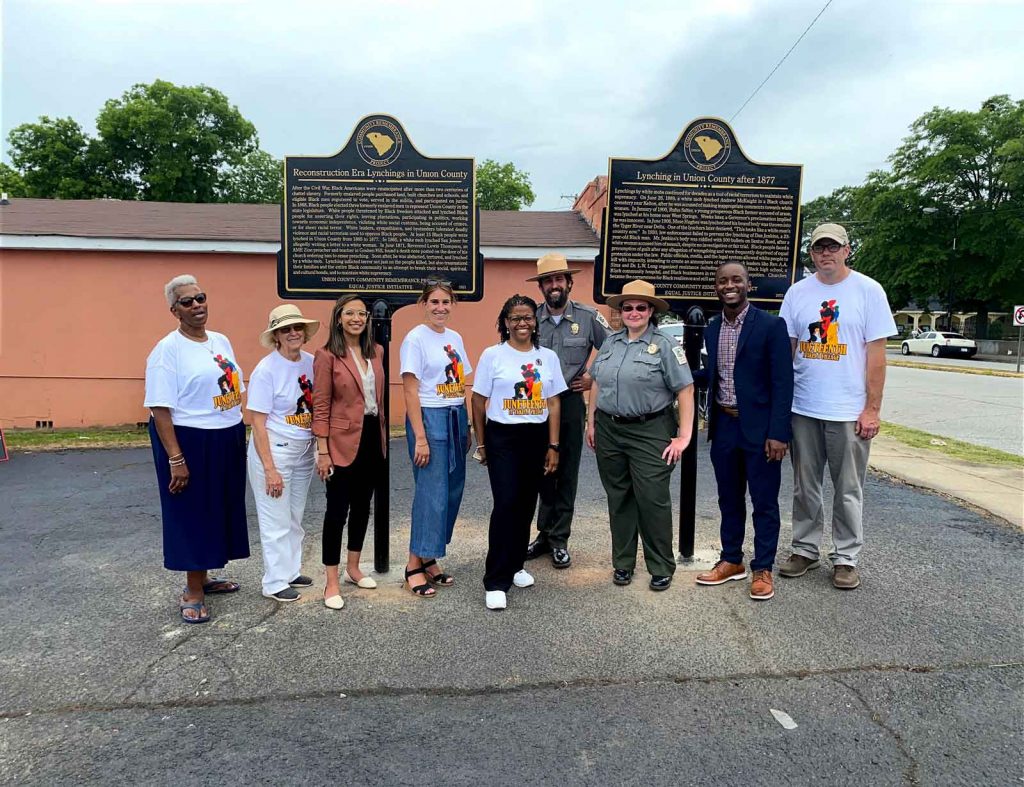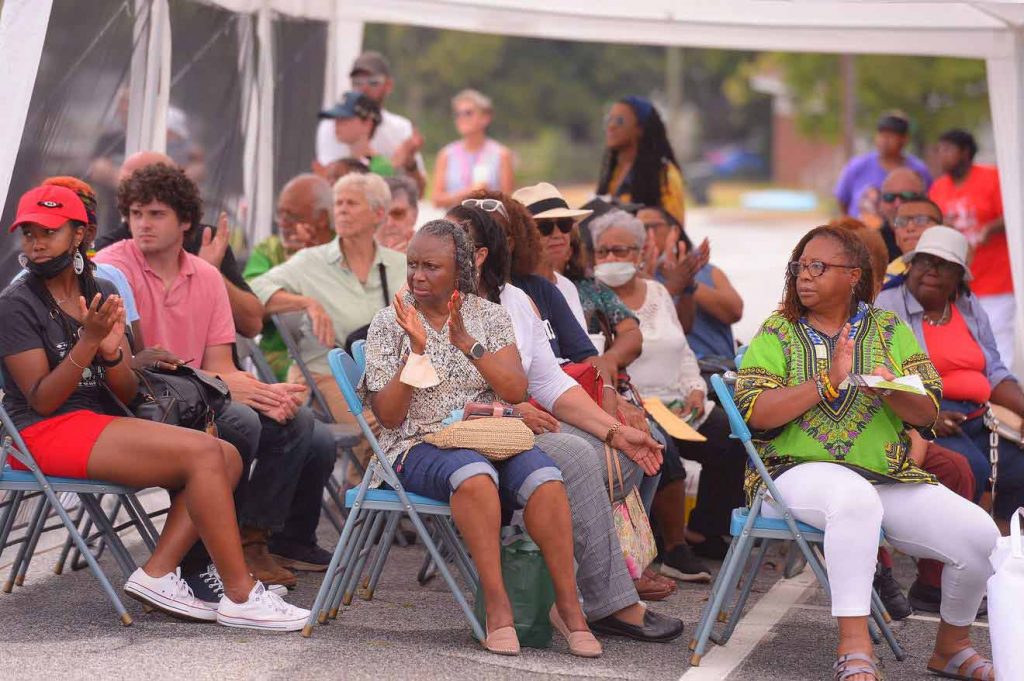On June 19, nearly 200 people gathered in the City of Union in South Carolina to learn about the history of racial terrorism in their county, to memorialize the Black men, women, and children who were lynched between 1865 and 1950, and to acknowledge the ongoing resilience of the Black community. Attendees included descendants of the victims who were being memorialized and elders within the Union community.
The Union County Community Remembrance Project coalition partnered with EJI to unveil two historical markers in downtown Union. One documents the 1871 Union County Jail Raid Massacre in which 12 Black men were abducted and lynched by a white mob, and a second memorializes 19 victims of racial terror lynching killed in Union County between 1865 and 1950. The coalition also unveiled a marker in front of the historic jail where the 1871 massacre took place that was sponsored by the South Carolina Historical Marker Program.
Following the marker unveilings, the coalition hosted a soil collection ceremony in which soil was placed in jars to memorialize the county’s 19 victims of racial terror lynching. Coalition member and Director of the Union Tourism Office, Curtiss Hunter, said, “By honoring the soil where lynching victims died, we are acknowledging the history of bloodshed that has seeped into the earth while simultaneously reclaiming it as sacred.”
The ceremony concluded with remarks from coalition leaders Kate Borchard-Schoen and Timika Wilson, who invited the audience to continue reflecting on this history by reading the markers and placing soil in the jars.
“Our past informs our present. There is both power and healing in telling the truth about our history of racial violence and it is the foundation for our justice-centered approach,” said Timika Wilson. “We believe that by engaging in truth-telling about Union’s lynching history, we are recognizing the impact it had on the community, acknowledging the unjust systems that still cause harm today, and seeking to write a different story about Union’s future.”
After the dedication ceremonies, community members participated in a Juneteenth celebration festival with local arts, food, and wellness vendors.
Reconstruction Era Lynching in Union County
After the Civil War, Black Americans were emancipated after more than two centuries of chattel slavery. Formerly enslaved people purchased land and built churches and schools, and eligible Black men registered to vote, served in the militia, and participated on juries.
In 1868, Black people elected three formerly enslaved men to represent Union County in the state legislature. White people threatened by Black freedom attacked and lynched Black people for asserting their rights, leaving plantations, participating in politics, working towards economic independence, violating white social customs, being accused of crimes, or for sheer racial terror. White leaders, sympathizers, and bystanders tolerated deadly violence and racial terrorism used to oppress Black people.
At least 15 Black people were lynched in Union County from 1865 to 1877. In 1865, a white mob lynched Sax Joiner for allegedly writing a letter to a white woman. In 1871, Reverend Lewis Thompson, an AME Zion preacher and teacher in Goshen Hill, found a death note posted on the door of his church ordering him to cease preaching. Soon after, he was abducted, tortured, and lynched by a white mob.
Lynching inflicted terror not just on the people killed, but also traumatized their families and the entire Black community in an attempt to break their social, spiritual, and cultural bonds, and to maintain white supremacy.
1871 Union County Jail Raid Massacre
The devastating Union County Jail Raid Massacre was one example of how racial violence was designed to terrorize the Black community during Reconstruction.
On January 4 and February 12, 1871, white mobs abducted 12 Black men from the county jail. Captain J. Alexander Walker, Charner Gordon, Andrew Thompson, Sylvanus Wright, Barret Edwards, Thomas Byers, Aaron Thompson, Joseph Vanlue, Ellison Scott, William Fincher, Mac Bobo, and Amos McKissick were hanged or shot at the ‘hanging grounds’ before any determination was made of their guilt.
These Black men were South Carolina state militia members who were accused of killing a white man named Mat Stevens while he was illegally transporting bootleg whiskey.
Months later, the U.S. Congress held hearings in former Confederate states to investigate incidents of racial violence, including the Union Jail Raid Massacre. By the time of the hearings, some Black people had already fled the area, but despite intimidation, many family and community members like Eliza Chalk and Samuel Nuckles bravely testified.
No one was held accountable for this massacre and other acts of violence. Union County’s Black community resisted violence by migrating to safety or staying and building community institutions. Their resilience demonstrated powerful opposition to continued white supremacy throughout Reconstruction, Jim Crow, and beyond.

/
Timika Wilson and Kate Borchard Schoen, Co-Liaisons of the Union County Community Remembrance Project, speak during the marker dedication ceremony on June 19, 2021.
Tim Kimzey/Spartanburg Herald-Journal
/
Dr. Vera Jeter-Jones adds soil to a jar memorializing her ancestor, Mabry Lyles, who was lynched in Union County in 1934.
Tim Kimzey/Spartanburg Herald-Journal
/
Members of the Union County Community Remembrance Project and EJI staff stand in front of the newly erected historical markers in Union County.

/
Community members attending the marker dedication ceremony in Union County, South Carolina, on June 19, 2021.
Tim Kimzey/Spartanburg Herald-Journal
/
A man adds soil to a jar memorializing Lewis Thompson, who was lynched in Union County in 1871.
Tim Kimzey/Spartanburg Herald-JournalLynching in Union County after 1877
Lynchings by white mobs continued for decades as a tool of racial terrorism to maintain white supremacy.
On June 26, 1889, a white mob lynched Andrew McKnight in a Black church cemetery near Kelton after he was accused of making inappropriate comments towards white women.
In January 1900, Rufus Salter, a young prosperous Black farmer accused of arson, was lynched at his home near West Springs. Weeks later, a governor’s proclamation implied he was innocent.
In June 1906, Mose Hughes was lynched and his bound body was thrown into the Tyger River near Delta. One of the lynchers later declared, “This looks like a white man’s country now.”
In 1930, law enforcement failed to prevent the lynching of Dan Jenkins, a 23-year-old Black man. Mr. Jenkins’s body was riddled with 500 bullets on Santuc Road after a white woman accused him of assault, despite no investigation or fair trial.
Black people faced a presumption of guilt after any allegation of wrongdoing and were frequently deprived of equal protection under the law. Public officials, media, and the legal system allowed white people to kill with impunity, intending to create an atmosphere of terror.
Black leaders like the Rev. A.A. Sims and Dr. L.W. Long organized resistance, establishing a Black high school, a Black community hospital, and Black businesses in response to racial inequities. Churches became the cornerstone for Black resilience and still are to this day.
Union County Community Remembrance Project
The Union County Community Remembrance Project developed as a way to address the history of racial terrorism, violence, and lynching in Union County. Many people in Union County have long been aware of the history of racial violence that happened here and some lynchings are still remembered in the local community today.
Community members and leaders, including South Carolina State Park Service staff from Rose Hill Plantation State Historic Site, Union County’s tourism director, NAACP leaders, and the mayor and his staff came together to form a coalition of people invested in telling the truth about Union’s history. These early coalition leaders saw an opportunity to develop the project as one of EJI’s Community Remembrance Projects and helped get the project off the ground in the fall of 2019. The South Carolina African American Heritage Commission organized the first meeting between all key coalition members in January 2020.
Lynching in America
In Lynching in America and Reconstruction in America, EJI has documented nearly 6,500 racial terror lynchings in America between 1865 and 1950. Thousands more Black people have been killed by white mob lynchings whose deaths may never be discovered. The lynching of African Americans was a form of racial terrorism intended to intimidate Black people and enforce racial hierarchy and segregation.
Lynching became the most public and notorious form of terror and subordination. White mobs were usually permitted to engage in racial terror and brutal violence with impunity. Many Black people were pulled out of jails or given over to mobs by law enforcement officials who were legally required to protect them. Terror lynchings often included burning and mutilation, sometimes in front of crowds numbering in the thousands.
In response to this racial terror and violence, millions of Black people fled the South and could never return, which deepened the anguish and pain of lynching. Many of the names of lynching victims were not recorded and will never be known.
EJI’s Community Remembrance Project
EJI’s Community Remembrance Project is part of our campaign to recognize the victims of lynching by collecting soil from lynching sites, erecting historical markers, and developing the National Memorial for Peace and Justice, which acknowledges the horrors of racial injustice.
As part of its effort to help towns, cities, and states confront and recover from tragic histories of racial violence and terrorism, EJI is joining with communities to install historical markers in communities where the history of lynching is documented.
We believe that understanding the era of racial terror is critical if we are to confront its legacies in the challenges that we currently face from mass incarceration, excessive punishment, police violence, and the presumption of guilt and dangerousness that burdens people of color today.